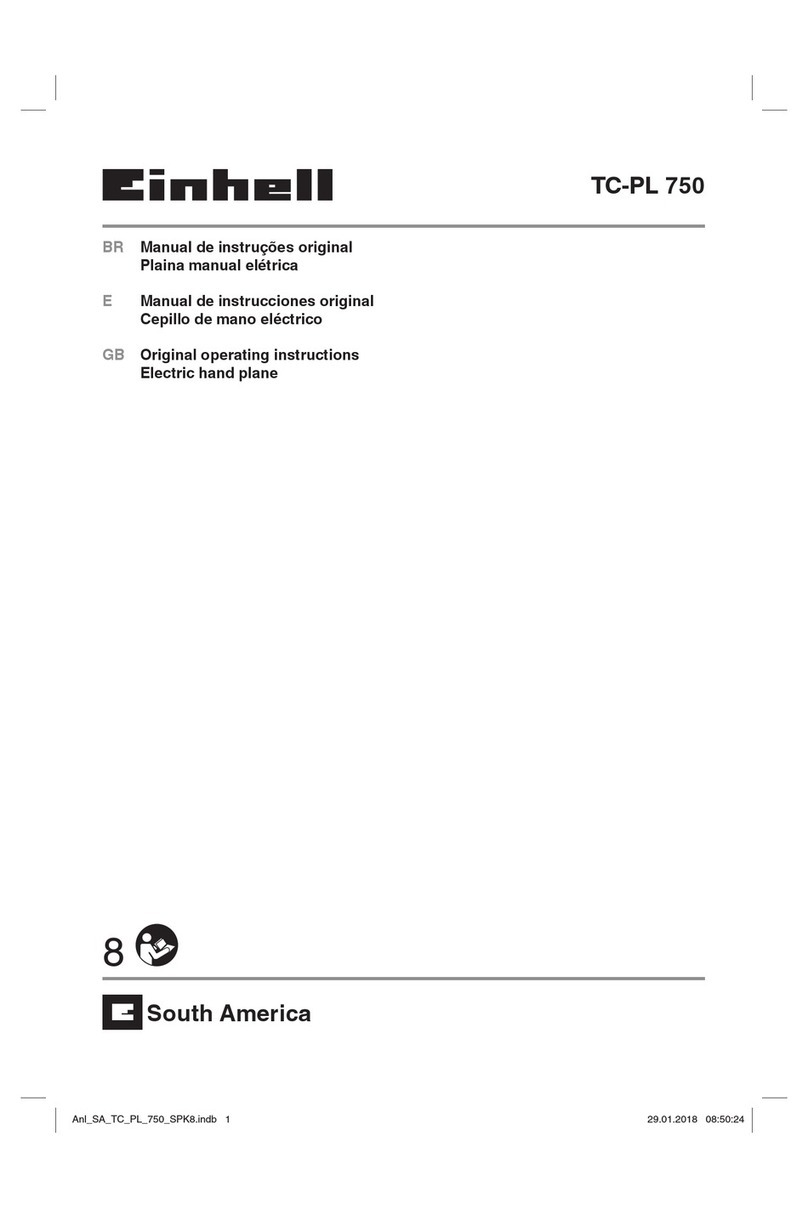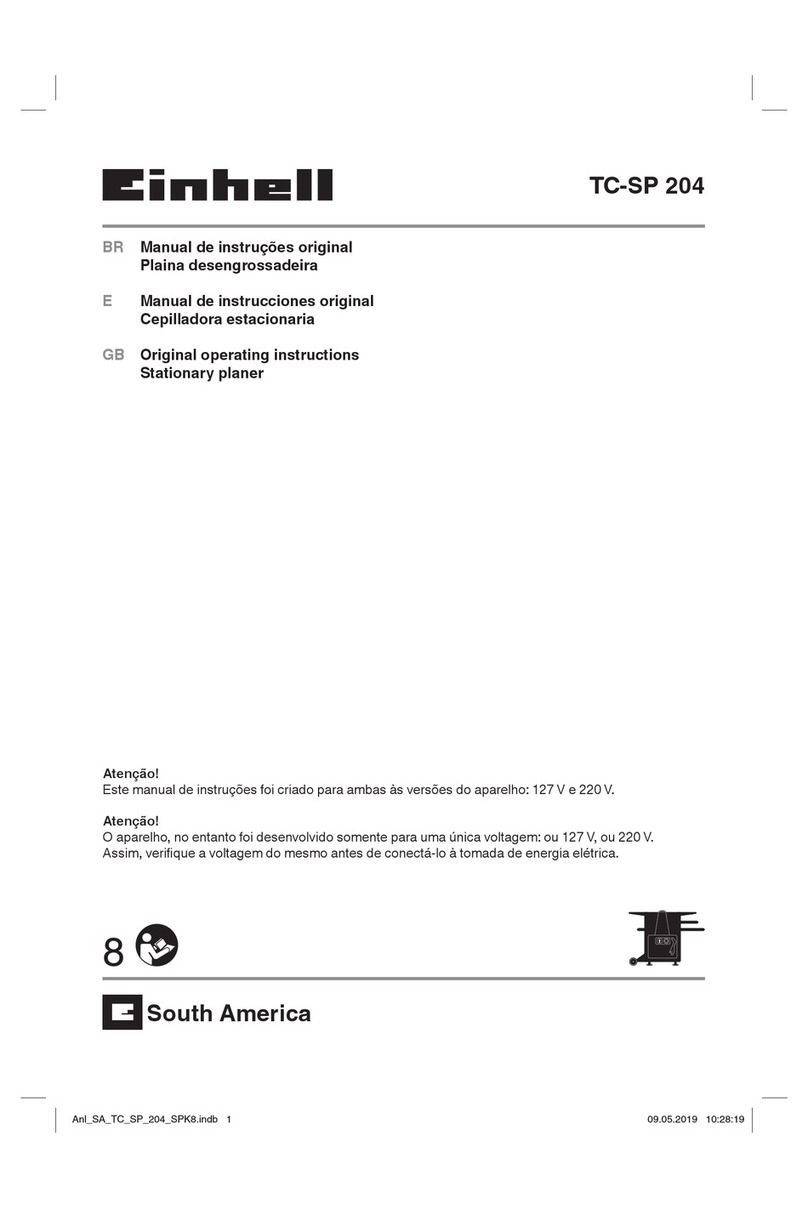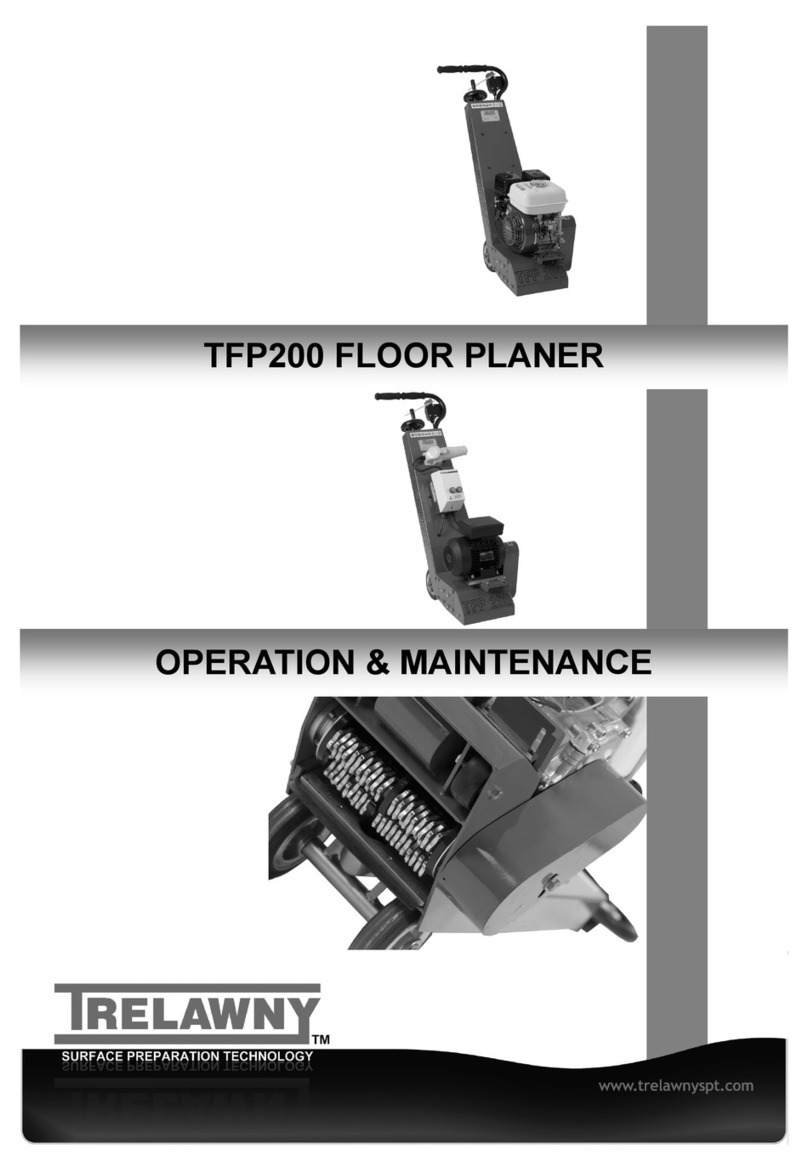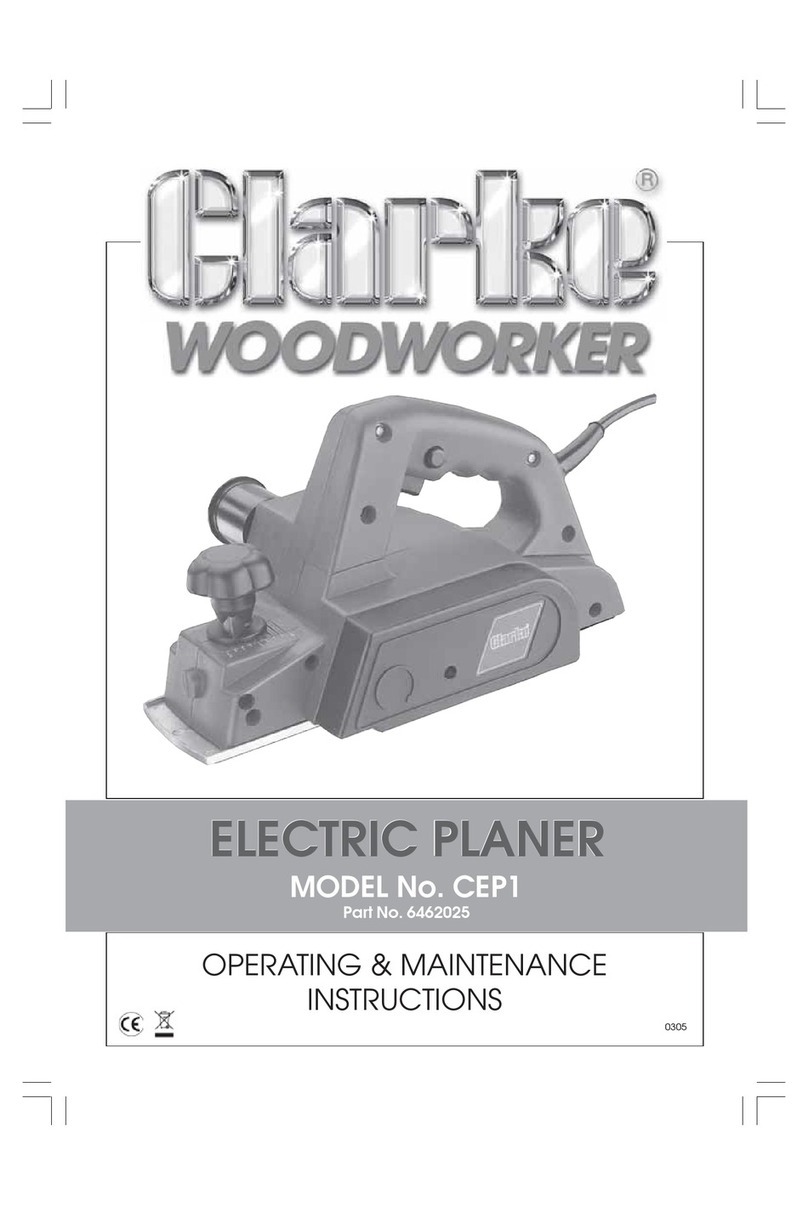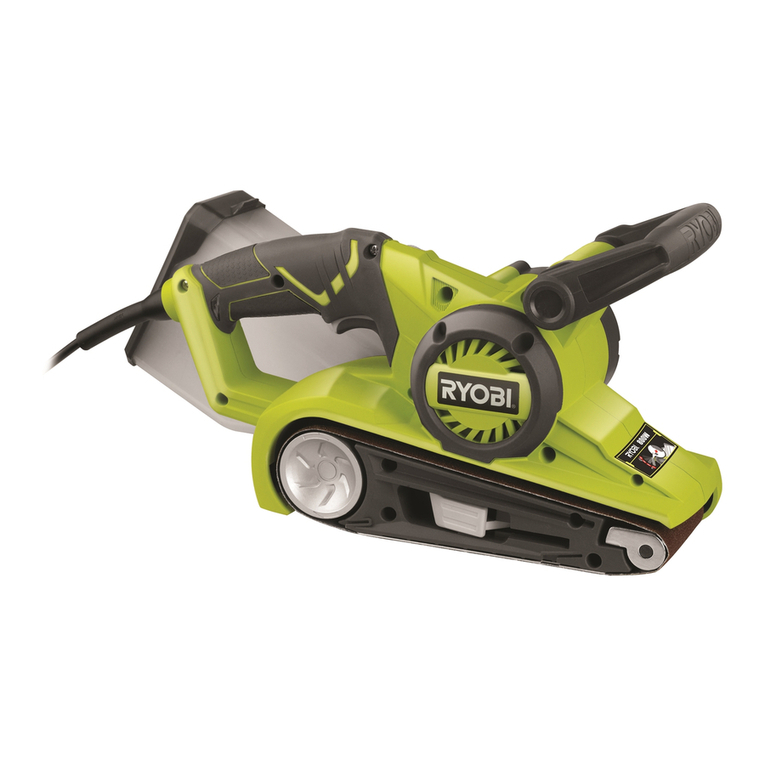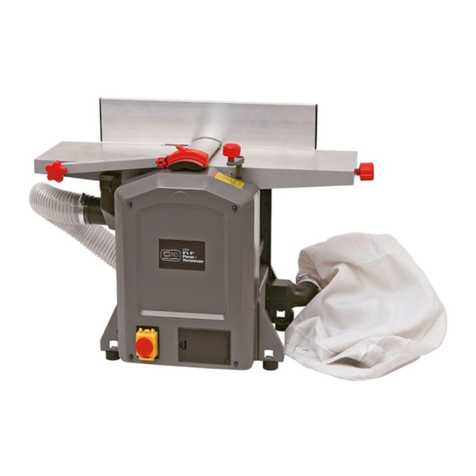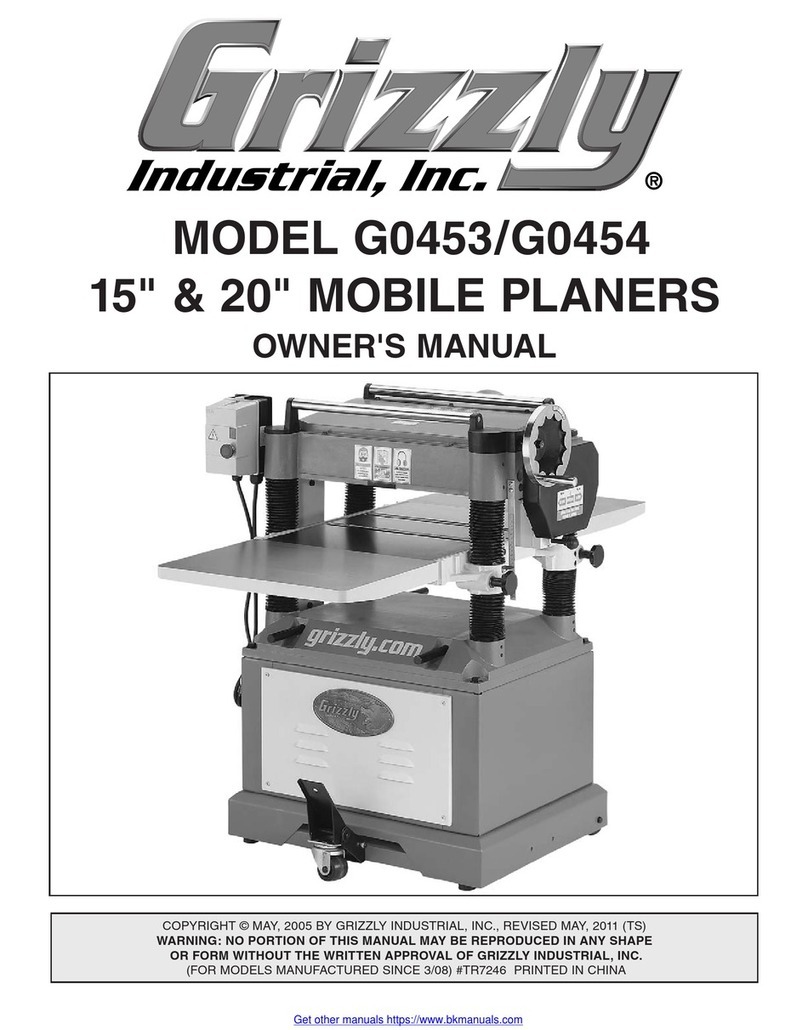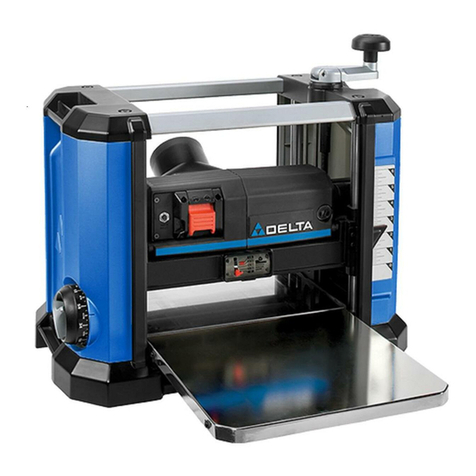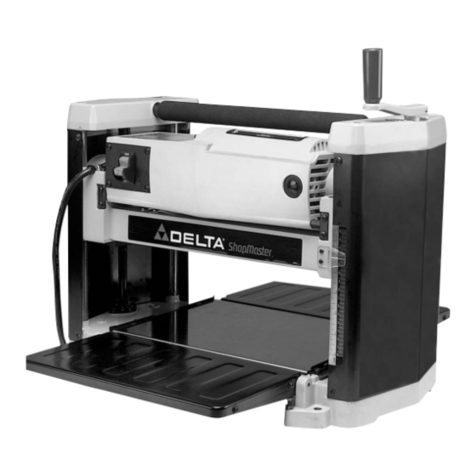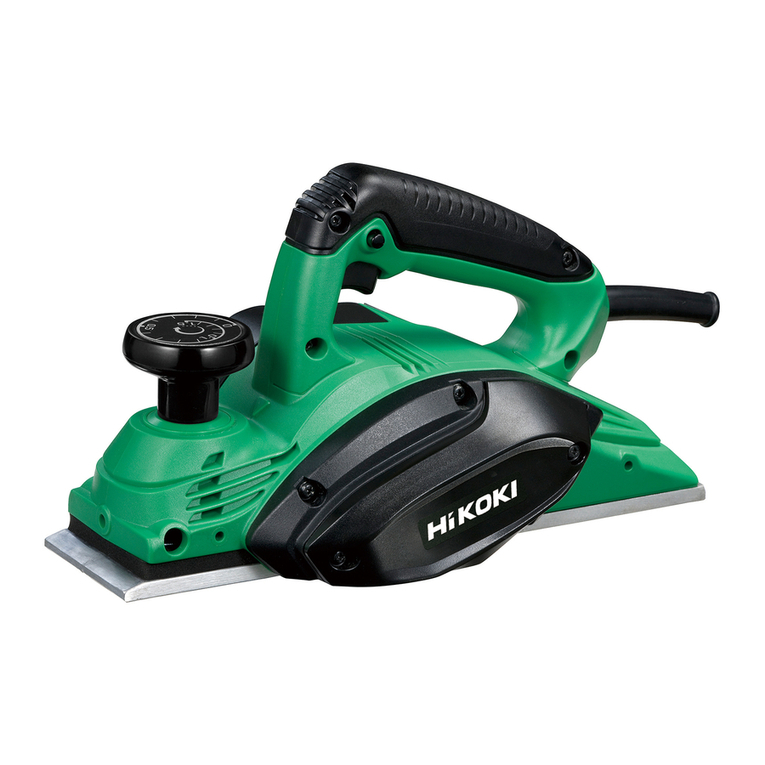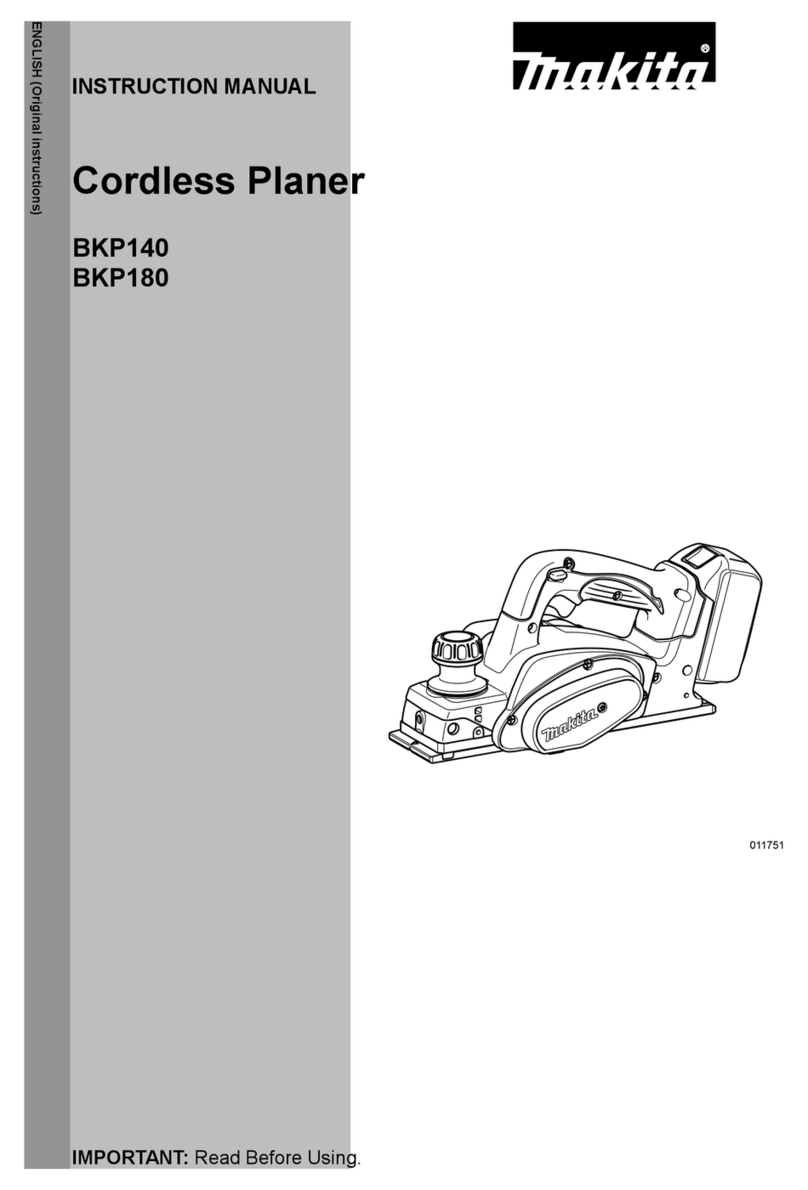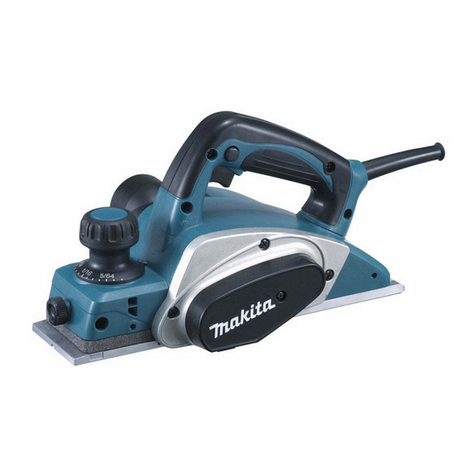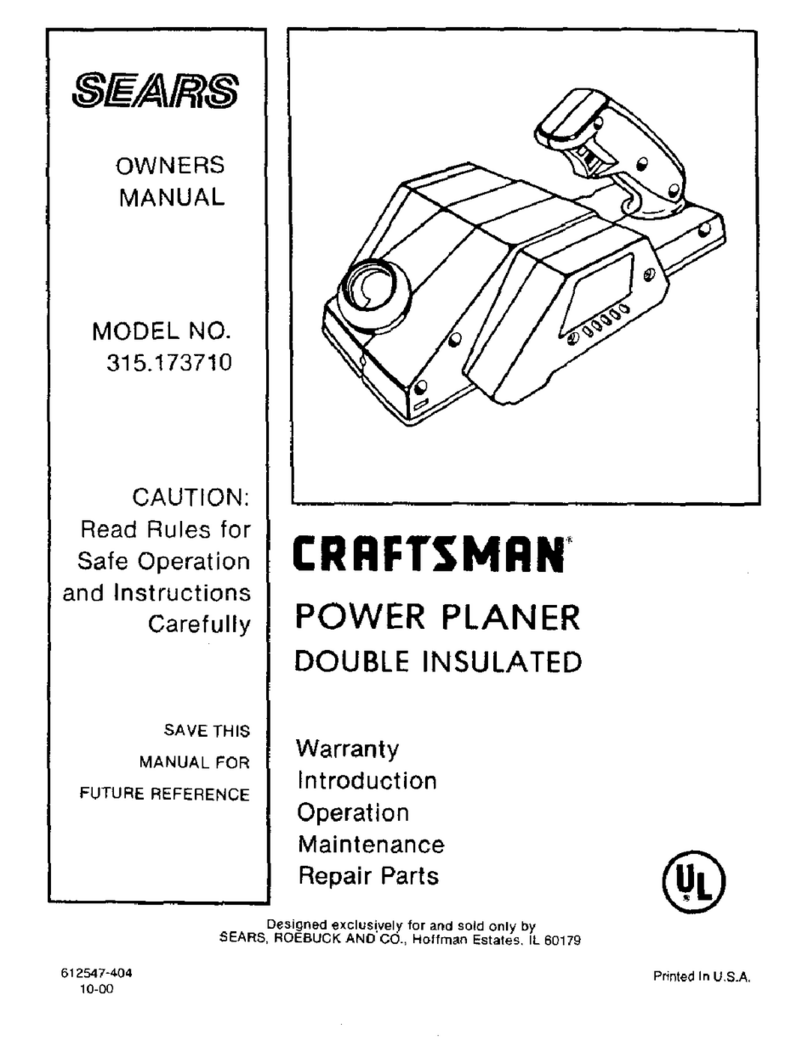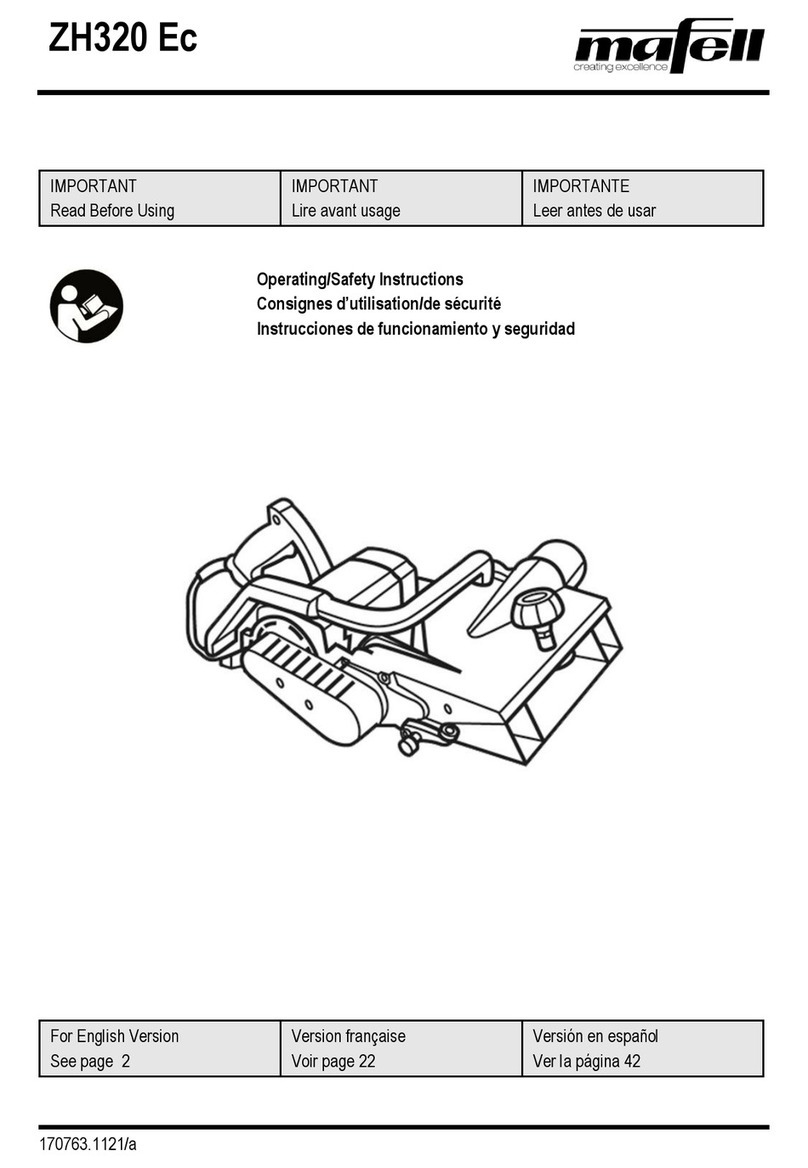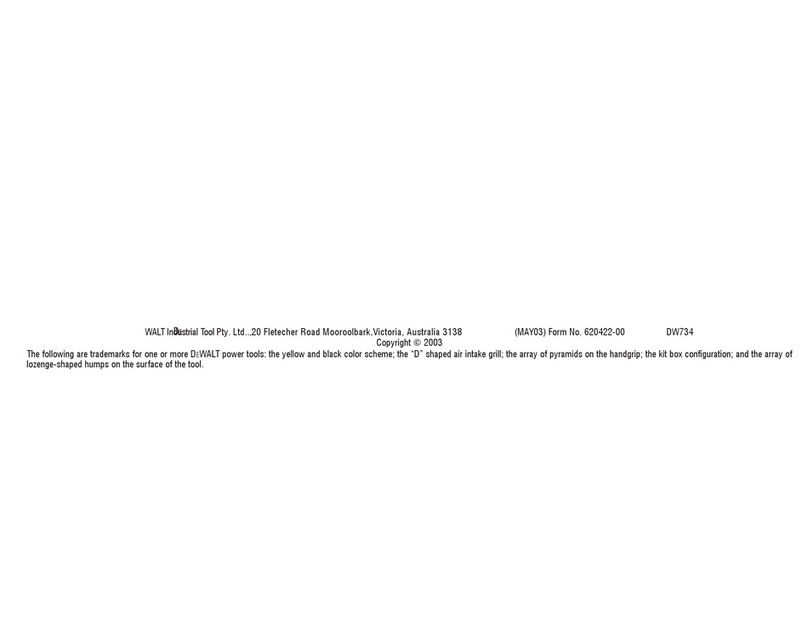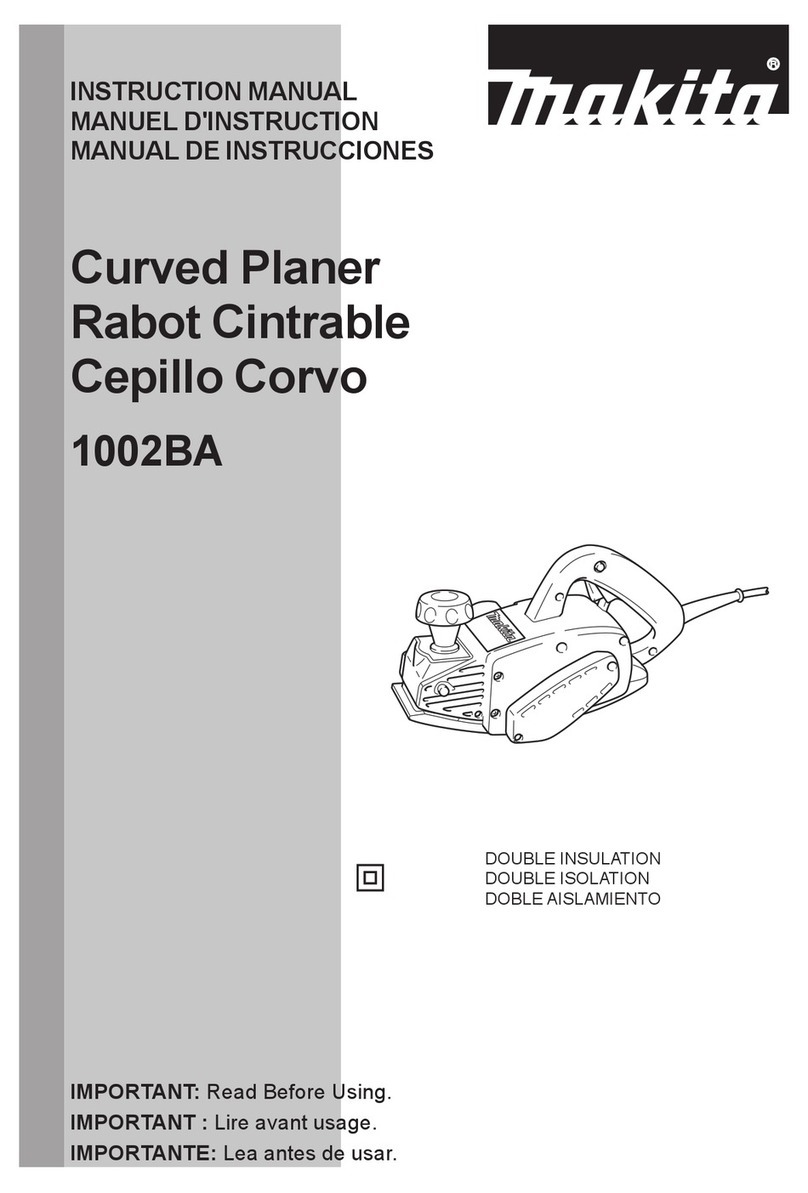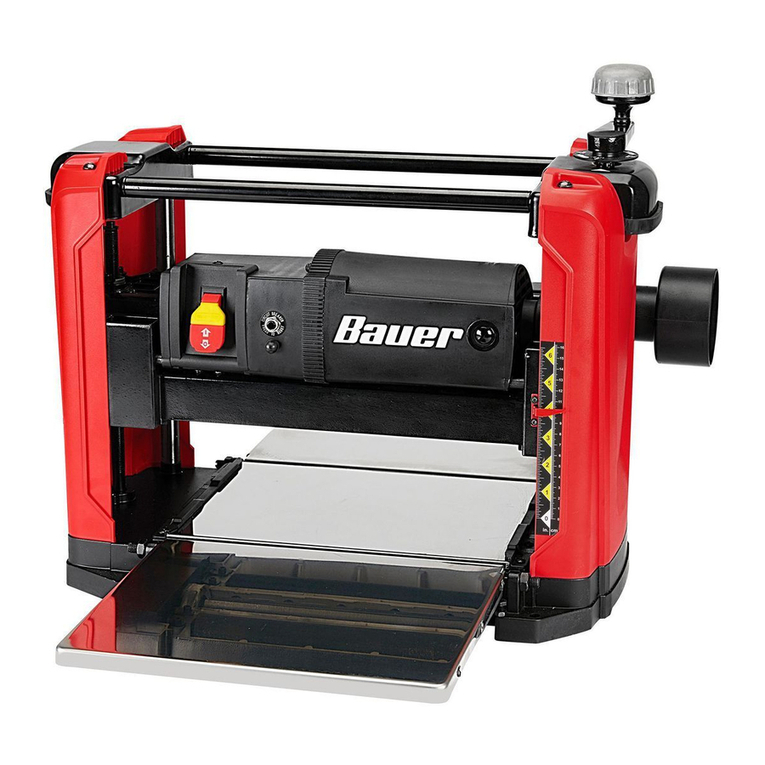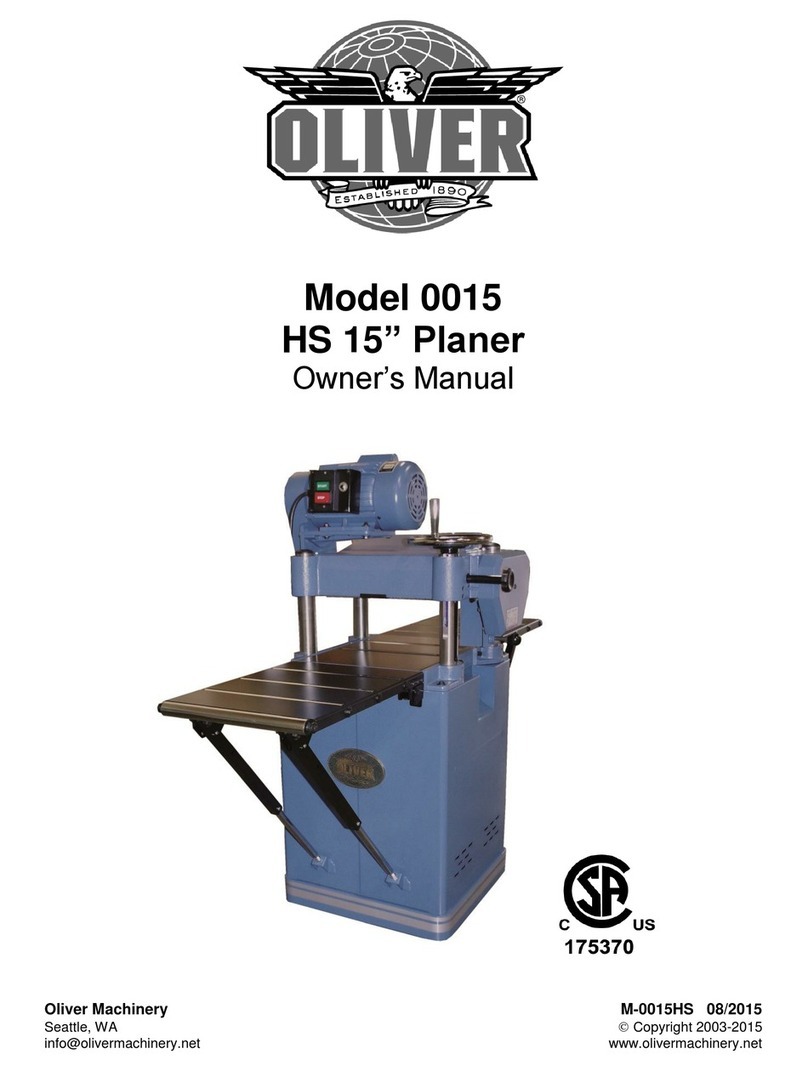EINHELL TE-PL 18/82 Li User manual

TE-PL 18/82 Li
Art.-Nr.: 4345401 I.-Nr.: 21010
7
EN Original operating instructions
Cordless Planer
SP Manual de instrucciones original
Cepillo inalámbrico
FR Traduction du mode d’emploi
d’origine
Rabot sans fil
Anl_TE_PL_18_82_Li_SPK7_USA.indb 1Anl_TE_PL_18_82_Li_SPK7_USA.indb 1 31.03.2021 13:52:5031.03.2021 13:52:50

- 2 -
1
2
8
5
2
3
3
12
6
109 7
4
1
1
11
Anl_TE_PL_18_82_Li_SPK7_USA.indb 2Anl_TE_PL_18_82_Li_SPK7_USA.indb 2 31.03.2021 13:52:5131.03.2021 13:52:51

- 3 -
4 5
6
8
3
7
16 15
11
8
9
18
12
13
14
4
9 10
17
Anl_TE_PL_18_82_Li_SPK7_USA.indb 3Anl_TE_PL_18_82_Li_SPK7_USA.indb 3 31.03.2021 13:52:5331.03.2021 13:52:53

- 4 -
11
12
6
19
10
20 21 22
13
23
24 25
Anl_TE_PL_18_82_Li_SPK7_USA.indb 4Anl_TE_PL_18_82_Li_SPK7_USA.indb 4 31.03.2021 13:52:5931.03.2021 13:52:59

EN
- 5 -
Table of contents
1. Safety information
2. Layout and items supplied
3. Intended use
4. Technical data
5. Before starting the equipment
6. Operation
7. Cleaning, maintenance and ordering spare parts
8. Disposal and recycling
9. Storage
Einhell USA LLC · 305 Veterans Blvd · Carlstadt · NJ 07072 · USA
Anl_TE_PL_18_82_Li_SPK7_USA.indb 5Anl_TE_PL_18_82_Li_SPK7_USA.indb 5 31.03.2021 13:53:0131.03.2021 13:53:01

EN
- 6 -
Danger! - Read the operating instructions to reduce the risk of injury
Caution! Wear ear-muffs. The impact of noise can cause damage to hearing.
Caution! Wear safety goggles. Sparks generated during work or splinters, chips and dust emitted by
the equipment can cause loss of sight.
Caution! Wear a breathing mask. Dust which is injurious to health can be generated when working on
wood and other materials. Never use the tool to work on any materials containing asbestos!
Store the batteries only in dry rooms with an ambient temperature of 50°F to 104°F (+10°C to +40°C).
Place only fully charged batteries in storage (charged at least 40%).
104°F
(+40°C)
50°F
(+10°C)
Anl_TE_PL_18_82_Li_SPK7_USA.indb 6Anl_TE_PL_18_82_Li_SPK7_USA.indb 6 31.03.2021 13:53:0131.03.2021 13:53:01

EN
- 7 -
DANGER!
When using the equipment, a number of safety
precautions must be observed to avoid injuries
and damage. Please read the complete operating
instructions and safety information with due care.
Keep these operating instructions in a safe place
so that the information is available at all times. If
you give the equipment to any other person, hand
over these operating instructions and the safety
information as well. We cannot accept any liabi-
lity for damage or accidents which arise due to
failure to follow these instructions and the safety
information.
1. Safety information
DANGER!
Read all the safety information and instruc-
tions. Failure to adhere to the safety information
and instructions set out below may result in elec-
tric shock, fire and/or serious injury. Keep all the
safety information and instructions in a safe
place for future use.
General safety information for power tools
The term „power tool“ used in the safety regulati-
ons refers to power tools operated from the mains
power supply (with a power cable) and to battery
operated power tools (without a power cable).
1) Work area safety
a) Keep work area clean and well lit. Clutte-
red and dark areas invite accidents.
b) Do not operate power tools in explosive
atmospheres, such as in the presence of
flammable liquids, gases or dust. Power
tools create sparks which may ignite the dust
or fumes.
c) Keep children and bystanders away while
operating a power tool. Distractions can
cause you to lose control.
2) Electrical safety
a) Power tool plugs must match the outlet.
Never modify the plug in any way. Do
not use any adapter plugs with earthed
(grounded) power tools. Unmodified plugs
and matching outlets will reduce risk of elec-
tric shock.
b) Avoid body contact with earthed or
grounded surfaces such as pipes, radia-
tors, ranges and refrigerators. There is an
increased risk of electric shock if your body is
earthed or grounded.
c) Do not expose power tools to rain or wet
conditions. Water entering a power tool will
increase the risk of electric shock.
d) Do not abuse the cord. Never use the
cord for carrying, pulling or unplugging
the power tool. Keep cord away from
heat, oil, sharp edges or moving parts.
Damaged or entangled cords increase the
risk of electric shock.
e) When operating a power tool outdoors,
use an extension cord suitable for out-
door use. Use of a cord suitable for outdoor
use reduces the risk of electric shock.
f) If operating a power tools in a damp lo-
cation is unavoidable, use a residual cur-
rent device (RCD) protected supply. Use
of an RCD reduces the risk of electric shock.
3) Personal safety
a) Stay alert, watch what you are doing and
use common sense when operating a
power tool. Do not use a power tool while
you are tired or under the influence of
drugs, alcohol or medication. A moment of
inattention while operating power tools may
result in serious personal injury.
b) Use personal protective equipment.
Always wear eye protection. Protective
equipment such as dust mask, non-skid safe-
ty shoes, hard hat, or hearing protection used
for appropriate conditions will reduce perso-
nal injuries.
c) Prevent unintentional starting. Ensure the
switch is in the off-position before con-
necting to power source and/or BATTERY
pack, picking up or carrying the tool.
Carrying power tools with your finger on the
switch or energising power tools that have the
switch on invites accidents.
d) Remove any adjusting key or wrench be-
fore turning the power tool on. A wrench
or a key left attached to a rotating part of the
power tool may result in personal injury.
e) Do not overreach. Keep proper footing
and balance at all times. This enables
better control of the power tool in unexpected
situations.
f) Dress properly. Do not wear loose
clothing or jewellery. Keep your hair,
clothing and gloves away from moving
parts. Loose clothes, jewellery or long hair
can be caught in moving parts.
g) If devices are provided for the connection
of dust extraction and collection facilities,
Anl_TE_PL_18_82_Li_SPK7_USA.indb 7Anl_TE_PL_18_82_Li_SPK7_USA.indb 7 31.03.2021 13:53:0131.03.2021 13:53:01

EN
- 8 -
ensure these are connected and properly
used. Use of these devices can reduce dust
related hazards.
h) Do not let familiarity gained from frequent
use of tools allow you to become compla-
cent and ignore tool safety principles. A
careless action can cause severe injury within
a fraction of a second.
4) Power tool use and care
a) Do not force the power tool. Use the cor-
rect power tool for your application. The
correct power tool will do the job better and
safer at the rate for which it was designed.
b) Do not use the power tool if the switch
does not turn it on and off. Any power tool
that cannot be controlled with the switch is
dangerous and must be repaired.
c) Disconnect the plug from the power
source and/or remove the battery pack,
if detachable, from the power tool before
making any adjustments, changing ac-
cessories, or storing power tools. Such
preventive safety measures reduce the risk of
starting the power tool accidentally.
d) Store idle power tools out of the reach of
children and do not allow persons unfa-
miliar with the power tool or these inst-
ructions to operate the power tool. Power
tools are dangerous in the hands of untrained
users.
e) Maintain power tools and accessories.
Check for misalignment or binding of
moving parts, breakage of parts and any
other condition that may affect the power
tool’s operation. If damaged, have the
power tool repaired before use. Many acci-
dents are caused by poorly maintained power
tools.
f) Keep cutting tools sharp and clean. Pro-
perly maintained cutting tools with sharp
cutting edges are less likely to bind and are
easier to control.
g) Use the power tool, accessories and tool
bits etc., in accordance with these inst-
ructions and in the manner intended for
the particular type of power tool, taking
into account the working conditions and
the work to be performed. Use of the power
tool for operations different from intended
could result in a hazardous situation.
h) Keep handles and grasping surfaces dry,
clean and free from oil and grease. Slip-
pery handles and grasping surfaces do not
allow for safe handling and control of the tool
in unexpected situations.
5) Battery tool use and care
a) Recharge only with the charger specified
by the manufacturer. A charger that is sui-
table for one type of battery pack may create
a risk of fire when used with another battery
pack.
b) Use power tools only with specifically
designated battery packs. Use of any other
battery packs may create a risk of injury and
fire.
c) When battery pack is not in use, keep it
away from other metal objects, like paper
clips, coins, keys, nails, screws or other
small metal objects that can make a
connection from one terminal to another.
Shorting the battery terminals together may
cause burns or a fire.
d) Under abusive conditions, liquid may be
ejected from the battery; avoid contact.
If contact accidentally occurs, flush with
water. If liquid contacts eyes, additionally
seek medical help. Liquid ejected from the
battery may cause irritation or burns.
e) Do not use a BATTERY pack or tool that is
damaged or modified. Damaged or modi-
fied batteries may exhibit unpredictable beha-
viour resulting in fire, EXPLOSION or risk of
injury.
f) Do not expose a BATTERY pack or tool to
fire or excessive temperature. Exposure to
fire or temperature above 266°F (130°C) may
cause explosion.
g) Follow all charging instructions and do
not charge the BATTERY pack or tool out-
side the temperature range specified in
the instructions. Charging improperly or at
temperatures outside the specified range may
damage the BATTERY and increase the risk
of fire.
6) Service
a) Have your power tool serviced by a qua-
lified repair person using only identical
replacement parts. This will ensure that the
safety of the power tool is maintained.
b) Never service damaged BATTERY packs.
Service of BATTERY packs should only be
performed by the manufacturer or authorized
service providers.
Additional safety instructions
We pay a great deal of attention to the design of
every battery pack to ensure that we supply you
Anl_TE_PL_18_82_Li_SPK7_USA.indb 8Anl_TE_PL_18_82_Li_SPK7_USA.indb 8 31.03.2021 13:53:0231.03.2021 13:53:02

EN
- 9 -
with batteries which feature maximum power den-
sity, durability and safety. The battery cells have
a wide range of safety devices. Each individual
cell is initially formatted and its electrical charac-
teristic curves are recorded.These data are then
used exclusively to be able to assemble the best
possible battery packs.
Despite all the safety precautions, caution
must always be exercised when handling bat-
teries.The following points must be obeyed
at all times to ensure safe use.
Safe use can only be guaranteed if undama-
ged cells are used. Incorrect handling can
cause cell damage.
Caution! Analyses confirm that incorrect use and
poor care are the main causes of the damage
caused by high performance batteries.
Information about the battery
1. The battery pack supplied with your cordless
tool is not charged.The battery pack has to
be charged before you use the tool for the first
time.
2. For optimum battery performance avoid low
discharge cycles. Charge the battery pack
frequently.
3. Store the battery pack in a cool place, ideally
at 59°F (15°C) and charged to at least 40%.
4. Lithium-ion batteries are subject to a natural
ageing process.The battery pack must be
replaced at the latest when its capacity falls to
just 80% of its capacity when new. Weakened
cells in an aged battery pack are no longer
capable of meeting the high power require-
ments and therefore pose a safety risk.
5. Do not throw battery packs into an open fire.
There is a risk of explosion!
6. Do not ignite the battery pack or expose it to
fire.
7. Do not exhaustively discharge batteries.
Exhaustive discharge will damage the bat-
tery cells.The most common cause of deep
discharge is lengthy storage or non-use of
partly discharged batteries. Stop working as
soon as the performance of the battery falls
noticeably or the electronic protection system
triggers. Place the battery pack in storage
only after it has been fully charged.
8. Protect batteries and the tool from over-
loads. Overloads will quickly result in over-
heating and cell damage inside the battery
housing without this overheating actually
being apparent externally.
9. Avoid damage and shocks. Replace batte-
ries which have been dropped from a height
of more than one meter or which have been
exposed to violent shocks without delay, even
if the housing of the battery pack appears to
be undamaged.The battery cells inside the
battery may have suffered serious damage.
In this respect, please also read the waste
disposal information.
10. If the battery pack suffers overloading and
overheating, the integrated protective cut-
offwill switch offthe equipment for safety
reasons. Caution! Do not press the ON/OFF
switch any more if the protective cut-offhas
actuated.This may damage the battery.
11. Use only original battery packs.The use of
other batteries may result in injuries, explosi-
on and a fire risk.
12. Protect your rechargeable battery against
moisture, rain and high humidity. Moisture,
rain and high humidity can cause dangerous
cell damage. Never charge or work with bat-
teries which have been exposed to moisture,
rain or high humidity – replace them immedia-
tely.
13. If your equipment is fitted with a detachable
battery, remove the battery for safety reasons
after you have finished your work
Information on chargers and the charging
process
1. Please check the data marked on the rating
plate of the battery charger. Be sure to con-
nect the battery charger to a power supply
with the voltage marked on the rating plate.
Never connect it to a different mains voltage.
2. Protect the battery charger and its cable from
damage and sharp edges. Have damaged
cables repaired without delay by a qualified
electrician.
3. Keep the battery charger, batteries and the
cordless tool out of children‘s reach.
4. Do not use damaged battery chargers.
5. Do not use the supplied battery charger to
charge other cordless tools.
6. In heavy use the battery pack will become
warm. Allow the battery pack to cool to room
temperature before commencing with the
charging.
7. Do not over-charge batteries. Do not ex-
ceed the maximum charging times.These
charging times apply only to discharged
batteries. Frequent insertion of a charged
or partly charged battery pack will result in
over-charging and cell damage. Do not leave
batteries in the charger for days on end.
y
Anl_TE_PL_18_82_Li_SPK7_USA.indb 9Anl_TE_PL_18_82_Li_SPK7_USA.indb 9 31.03.2021 13:53:0231.03.2021 13:53:02

EN
- 10 -
8. Never use or charge batteries if you sus-
pect that the last time they were charged
was more than 12 months previously. The-
re is a high probability that the battery pack
has already suffered dangerous damage
(exhaustive discharge).
9. Charging batteries at a temperature below
50°F (10°C) will cause chemical damage to
the cell and may cause a fire.
10. Do not use batteries which have heated du-
ring the charging process, as the battery cells
may have suffered dangerous damage.
11. Do not use batteries which have suffered
curvature or deformation during the charging
process or which show other non-typical sym-
ptoms (gassing, hissing, cracking,…)
12. Never fully discharge the battery pack (re-
commended depth of discharge max. 80%)
A complete discharge of the battery pack will
lead to premature ageing of the battery cells.
13. Never charge the batteries unsupervised.
Protection from environmental influences
1. Wear suitable work clothes.Wear safety gog-
gles.
2. Protect your cordless tool and the battery
charger from moisture and rain. Moisture
and rain can cause dangerous cell damage.
3. Do not use the cordless tool or the battery
charger near vapors and inflammable liquids.
4. Use the battery charger and cordless tools
only in dry conditions and an ambient tempe-
rature of 50°F to 104°F (10°C to 40°C).
5. Do not keep the battery charger in places
where the temperature is liable to reach over
104°F (40°C). In particular, do not leave the
battery charger in a car that is parked in the
sunshine.
6. Protect batteries from overheating. Over-
loads, over-charging and exposure to direct
sunlight will result in overheating and cell
damage. Never charge or work with batteries
which have been overheated – replace them
immediately if possible.
7. Storage of batteries, battery chargers and
cordless tools. Store the charger and your
cordless tool only in dry places with an am-
bient temperature of 50°F to 104°F (10°C to
40°C). Store the lithium-ion rechargeable bat-
tery in a cool and dry place at 50°F to 68°F
(10°C to 20°C). Protect them from humidity
and direct sunlight! Place only fully charged
batteries in storage (charged at least 40%).
8. Prevent the lithium-ion battery pack from free-
zing. Battery packs which were stored below
32°F (0°C) for more than 60 minutes must be
disposed of.
9. When handling batteries beware of electro-
static charge: Electrostatic discharges cause
damage of the electronic protection system
and the battery cells. Avoid electrostatic char-
ging and never touch the battery poles.
Battery Caution + Disposal
Disposal
Should your appliance need replacement af-
ter extended use, do not dispose of it with the
household refuse, but in an environmentally safe
way.
Waste produced by electrical machine
items should not be handled like normal
household rubbish. Please recycle where
recycle facilities exist. Check with your local
authority or retailer for recycling advice.
Always dispose of your battery pack according
to federal, state, and local regulations. Contact a
recycling agency in your area for recycling loca-
tions.
CAUTION! Even discharged battery packs
contain some energy. Before disposing, use elec-
trical tape to cover the terminals to prevent the
battery pack from shorting, which could cause a
fire or explosion.
WARNING! To reduce the risk of injury or
explosion, never burn or incinerate a battery
pack even if it is damaged, dead, or completely
discharged.When burned, toxic fumes and mate-
rials are emitted into the surrounding atmosphere.
1. Batteries vary according to device. Consult
your manual for specific information.
2. Install only new batteries of the same type in
your product (where applicable).
3. Failure to insert batteries in the correct polari-
ty, as indicated in the battery compartment or
manual, may shorten the life of the batteries
or cause batteries to leak.
4. Do not mix old and new batteries.
5. Do not mix Alkaline, Standard (Carbon-Zinc),
or Rechargeable (Nickel Cadmium, Nickel
Metal Hydride, or Lithium-Ion) batteries.
6. Do not dispose of batteries in fire.
7. Batteries should be recycled or disposed of
as per state and local guidelines.
When shipping or disposing of batteries and
cordless tools, always ensure that they are
packed individually in plastic bags to prevent
short circuits and fires.
Anl_TE_PL_18_82_Li_SPK7_USA.indb 10Anl_TE_PL_18_82_Li_SPK7_USA.indb 10 31.03.2021 13:53:0231.03.2021 13:53:02

EN
- 11 -
Special safety information
Secure the workpiece whenever possible: Use
clamps or a vise to hold the workpiece securely.
This is far safer than holding it in your hand and
also means that you have both hands free to ope-
rate the electric tool.
Safety information for planes
• Wait for the cutter to stop before setting
the tool down. An exposed rotating cutter
may engage the surface leading to possible
loss of control and serious injury.
• Hold the power tool by insulated gripping
surfaces, because the cutter may contact
its own cord. Cutting a “live” wire may make
exposed metal parts of the power tool “live”
and could give the operator an electric shock.
• Use clamps or another practical way to
secure and support the workpiece to a
stable platform. Holding the workpiece by
your hand or against the body leaves it unsta-
ble and may lead to loss of control.
• To avoid damage to the electric plane, make
sure there are no foreign objects attached to
the workpiece.
• Hold the tool’s handle in both hands; place
the front base plate of the plane on the work-
piece.The base plates must lie flat on the
workpiece while planing is in progress.
• Allow the tool to reach its full speed before
you begin planing.
• Set the chip depth to 0 mm when you have
finished your work.
• The planing knives should be replaced by a
new pair of planing knives as soon as they
become worn.
• Some types of planing knife have two blades.
If one of the blades becomes blunt, the pla-
ning knife can be reversed.
• Blunt planing knives cannot be resharpened.
• Always replace both knives.
• Only the original knife shaft from the manu-
facturer is allowed to be used for this electric
plane.
• To work well and safely you must use only
clean and sharp planing knives.
SAVE THESE INSTRUCTIONS
2. Layout and items supplied
2.1 Layout
1. Setting knob for the chip depth
2. Chip ejector
3. Safety lock-off
4. On/Offswitch
5. Rear base plate
6. Belt cover
7. Parking soleplate
8. Front base plate
9. Thumb screw for step depth scale
10. Step depth scale
11. Parallel stop
12. Wrench
13. Mounting
14. Thumb screw
15. Lock bolt
16. Wing nut
17. V-shaped groove
18. Hexagonal screws
19. Screws
20. Belt pulley, large
21. Drive belt
22. Belt pulley, small
23. Battery capacity indicator
24. Battery capacity indicator button
25. Pushlock button
2.2 Items supplied
Please check that the article is complete as
specified in the scope of delivery. If parts are
missing, please contact our service center or the
store where you made your purchase at the latest
within 5 work days after purchasing the article and
upon presentation of a valid bill of purchase.
• Open the packaging and take out the equip-
ment with care.
• Remove the packaging material and any
packaging and/or transportation braces (if
present).
• Check to see if all the items are supplied.
• Inspect the equipment and accessories for
transport damage.
• If possible, keep the packaging until the end
of the guarantee period.
Danger!
The equipment and packaging material are
not toys. Do not let children play with plastic
bags, plastic sheets and small parts.There is
a risk of choking and suffocating!
Anl_TE_PL_18_82_Li_SPK7_USA.indb 11Anl_TE_PL_18_82_Li_SPK7_USA.indb 11 31.03.2021 13:53:0231.03.2021 13:53:02

EN
- 12 -
• Cordless Planer
• Step depth scale
• Parallel stop
• Wrench
• Original operating instruction with safety in-
formation
Separately available accessories
18V 1.5Ah P-X-C lithium-ion battery
18V 2.0Ah P-X-C lithium-ion battery
18V 2.5Ah P-X-C lithium-ion battery
18V 3.0Ah P-X-C lithium-ion battery
18V 4.0Ah P-X-C lithium-ion battery
18V 5.2Ah P-X-C Plus lithium-ion battery
18V 4-6 Multi Ah P-X-C Plus lithium-ion battery
18V P-X-C Dual Port Fast Charger
18V P-X-C Fast Charger
Explore battery + charger options at
einhellUSA.com
3. Intended use
The cordless planer is designed for planing, reba-
ting and chamfering pieces of wood.
The equipment is allowed to be used only for its
prescribed purpose. Any other use is deemed to
be a case of misuse.The user/operator and not
the manufacturer will be liable for any damage or
injuries of any kind resulting from such misuse.
Please note that our equipment has not been de-
signed for use in commercial, trade or industrial
applications. Our warranty will be voided if the
equipment is used in commercial, trade or indust-
rial businesses or for equivalent purposes.
4. Technical data
Motor power supply: ............................18 V
No-load speed: ....................... 15.000 rpm (min-1)
Planing width:............................... 31/4in. (83 mm)
Planing depth:..................1/64 in. to 5/64 (0.4-2 mm)
Maximum rabbet depth:.................. 5/16 in. (8 mm)
Weight (Tool only): ........................5.3 lbs (2.4 kg)
Wear ear-muffs.
The impact of noise can cause damage to hea-
ring.
Reduce noise generation and vibration to a
minimum!
• Use only equipment that is in perfect condi-
tion.
• Maintain and clean the equipment regularly.
• Adapt your way of working to the equipment.
• Do not overload the equipment.
• Have the equipment checked if necessary.
• Switch off the equipment when not in use.
• Wear gloves.
CAUTION!
Residual risks
Even if you use this electric power tool in
accordance with the instructions, certain
residual risks cannot be eliminated.The fol-
lowing hazards may arise in connection with
the equipment‘s construction and layout:
1. Lung damage if no suitable protective dust
mask is used.
2. Damage to hearing if no suitable ear protec-
tion is applied.
3. Health damage caused by hand-arm vibra-
tions if the equipment is used over a longer
period or is not properly guided and maintai-
ned.
Limit the operating time.
All stages of the operating cycle must be conside-
red (for example, times in which the electric tools
are switched offand times in which the tool is
switched on but operates without load).
5. Before starting the equipment
Warning!
Always remove the battery before making adjust-
ments to the tool.
5.1 Adjusting the chip depth (Fig. 3/Item 1)
You can adjust the chip depth in steps of 1/64 in. to
5/64 in. (0.4-2 mm) by turning the setting knob for
the chip depth (1) .
Turn the setting knob for the chip depth (1) clock-
wise: the chip depth will increase
Turn the setting knob for the chip depth (1) coun-
ter-clockwise: the chip depth will decrease
After finishing your work, set the chip depth so
that the knives are lowered and therefore protec-
ted from damage.Turn the setting knob for the
Anl_TE_PL_18_82_Li_SPK7_USA.indb 12Anl_TE_PL_18_82_Li_SPK7_USA.indb 12 31.03.2021 13:53:0231.03.2021 13:53:02

EN
- 13 -
chip depth to position “0” for this purpose.
5.2 Chip extraction (Fig. 1)
For optimum chip extraction you can connect the
equipment to a vacuum cleaner (not supplied).
To do so, insert the vacuum cleaner tube into the
chip discharge (2).
Important!
The vacuum cleaner you use for the vacuum ex-
traction must be suitable for the material you are
cutting.
5.3 Parallel stop (Fig. 4)
Use the parallel stop (11) when you want to plane
parallel to the edge of the workpiece.
Installing the parallel stop
• Fasten the mount (13) of the parallel stop
to the left side of the tool using the supplied
thumb screw (14).
• Now connect the mount (13) to the slide of
the parallel stop (11).
• The guide rail must always be aligned in
downward direction.
• Fix the distance required between the parallel
stop and the edge of the workpiece.
• Fasten the parts with the lock bolt (15) and
the wing nut (16).
6. Operation
6.1 ON/OFF switch (Fig. 5)
• The plane comes with a safety switch which
is designed to prevent accidents.
• To switch on the plane, press the side safety
lock-off (3) and press the ON/OFF switch (4).
• To switch off the plane, release the ON/OFF
switch (4).The ON/OFF switch (4) will return
to its starting position.
6.2 Practical tips
Warning! Only ever move the plane against the
workpiece while the plane is switched on.
6.2.1 Planing surfaces
Set the desired chip depth. Place the plane by its
front base plate onto the piece of wood you want
to machine and switch on the plane. Holding the
plane with both hands, push it over the surface
making sure that the front and the rear base plate
both lie fully on the workpiece. For the finish-
machining of surfaces use a small chip depth and
make several passes over the surface.
6.2.2 Chamfering edges (Fig. 6-7)
• There is a V-shaped groove (17) in the front
base plate that enables you to plane edges at
an angle of 45° for a smooth finish.
• Switch on the tool and wait for it to reach full
speed. Place the V-shaped groove (17) of the
plane against the edge of the workpiece at an
angle of 45°.
• Now move the plane along the edge of the
workpiece.
• To achieve high-quality results you should
keep the feed speed and angle constant.
6.2.3 Planing steps (Fig. 4/8)
• The planing of steps is possible with the help
of the parallel stop (11).
• Mount the parallel stop (11) on the left side of
the tool (see section 5.3).
• To mount the depth stop, use the locking
screw (9) to fasten the step depth scale (10)
to the front right side of the plane housing
(see Fig. 8).
• Release the locking screw (9) and position
the step depth scale (10) so that the required
step depth is displayed. Retighten the locking
screw (9).
Width of step:
You can set the width of the step with the parallel
stop (11).
Depth of step:
We recommend you to set a cutting depth of 2
mm and to keep planing the workpiece until the
required depth of step is reached.
6.3 Charging the Li battery pack
The corresponding instructions can be found in
the original operating instructions for your char-
ger.
6.4 Battery capacity indicator
(Fig. 13 / item 23)
Press the battery capacity indicator switch (24).
The battery capacity indicator (23) shows the
charge status of the battery using 3 LEDs.
All 3 LEDs lit:
The battery is fully charged.
2 or 1 LED(s) lit:
The battery has an adequate remaining charge.
Anl_TE_PL_18_82_Li_SPK7_USA.indb 13Anl_TE_PL_18_82_Li_SPK7_USA.indb 13 31.03.2021 13:53:0231.03.2021 13:53:02

EN
- 14 -
1 LED flashing:
The battery is empty, recharge the battery.
All LEDs flashing:
The battery pack has been deep-discharged and
is defective. Do not re-use or charge a defective
battery pack.
7. Cleaning, maintenance and
ordering spare parts
HAZARD!
Always take the battery out of the equipment be-
fore starting any cleaning work.
7.1 Cleaning
• Keep all safety devices, air vents and the
motor housing free of dirt and dust as far as
possible.Wipe the equipment with a clean
cloth or blow it down with compressed air at
low pressure.
• We recommend cleaning the equipment im-
mediately each time after use.
• Clean the equipment regularly with a damp
cloth and some soft soap. Do not use
cleaning agents or solvents; these may be ag-
gressive to the plastic parts in the equipment.
Ensure that no water can get into the interior
of the equipment.The ingress of water into
an electric power tool increases the risk of an
electric shock.
7.2 Maintenance
There are no other parts inside the equipment
which require maintenance.
7.3 Changing the planing knife (Fig. 9)
Danger! Remove the battery before doing any
work on the tool!
The plane is fitted with two reversible carbide
knives. Reversible knives have two cutting edges
and can be reversed.The guide slot on the rever-
sible knives ensures the same height setting after
a change.Worn, blunt or damaged knives must
be replaced.
Reversible carbide knives cannot be re-sharpe-
ned.
Undo the three hexagonal screws (18) with the
supplied wrench (12) and use a piece of wood to
push the reversible carbide blade sideways out of
the planing shaft (see Fig. 9).
Clean the knife seat before fitting. Install the kni-
ves in reverse order. Check that the planing knife
coincides with both ends of the planing shaft.
Always replace both knives to ensure a uniform
chip depth.
Danger! Before you switch on the plane make
sure the knives are installed securely and in the
right place.
Check the correct setting (Fig. 10)
(8) Front base plate (moving plane shoe)
(5) Rear base plate (fixed plane shoe)
1. Correct setting
Result: Smooth planed surface
2. Notches in the surface
Problem:The cutting edge of the planing knife (or
both planing knives) is not parallel to the height of
the rear base plate.
3. Furrows at the start of the planed surface
Problem:The cutting edge of the planing knife
(or both planing knives) is below the height of the
rear base plate.
4. Furrows at the end of the planed surface
Problem:The cutting edge of the planing knife
(or both planing knives) is above the height of the
rear base plate.
7.4 Replacing the drive belt (Fig. 11-12)
• The belt should be replaced by a trained ex-
pert.
• The drive belt (21) must be replaced if it is
worn.
• Undo the screws (19) and remove the side
belt cover (6).
• Remove the worn drive belt (21) and clean
the two belt pulleys (20/22).
• Place the new drive belt on the small belt
pulley (22) and pull the belt onto the large belt
pulley (20) while turning the planing shaft.
• Ensure that the longitudinal grooves on the
drive belt are in the guide grooves on the
drive wheels.
• Mount the belt cover (6) and secure it with the
screws (19).
7.5 Ordering replacement parts:
Service
1. If your power tool requires service, con-
tact an authorized Einhell USA dealer or
call the Einhell USA customer service
center at 1-866-EINHELL
Anl_TE_PL_18_82_Li_SPK7_USA.indb 14Anl_TE_PL_18_82_Li_SPK7_USA.indb 14 31.03.2021 13:53:0231.03.2021 13:53:02

EN
- 15 -
(1-866-346-4355). Only identical replace-
ment parts should be utilized for repairs.This
will ensure that the safety of the power tool is
maintained.
2. If the battery charger cable is damaged, it
must be immediately replaced to avoid a
hazard. Contact the Einhell USA®customer
service center at 1-866-EINHELL
(1-866-346-4355) for assistance.
To ensure that any defective/damaged lithi-
um-ion batteries are properly packaged and
delivered when you send them to us, please
contact our customer service or the point of
sale at which the equipment was purchased.
When shipping or disposing of batteries and
cordless tools, always ensure that they are
packed individually in plastic bags to prevent
short circuits and fires.
8. Disposal and recycling
The equipment is supplied in packaging to pre-
vent it from being damaged in transit.The raw
materials in this packaging can be reused or
recycled.The equipment and its accessories are
made of various types of material, such as metal
and plastic. Never place defective equipment in
your household refuse.The equipment should
be taken to a suitable collection center for proper
disposal. If you do not know the whereabouts of
such a collection point, you should ask in your
local council offices.
9. Storage
Store the equipment and its accessories out of
children‘s reach in a dark and dry place at above
freezing temperature.The ideal storage tempera-
ture is between 41°F and 86°F
(5°C and 30°C). Keep the electric tool in its origi-
nal packaging.
The reprinting or reproduction by any other me-
ans, in whole or in part, of documentation and pa-
pers accompanying the products is strictly subject
to the express consent of Einhell Germany AG.
Subject to technical changes
Anl_TE_PL_18_82_Li_SPK7_USA.indb 15Anl_TE_PL_18_82_Li_SPK7_USA.indb 15 31.03.2021 13:53:0231.03.2021 13:53:02

EN
- 16 -
EINHELL CUSTOMER PROMISE
PRODUCT REGISTRATION:
Einhell strongly encourages you to register
your purchase. You can register online at
EinhellUSA.com Failure to register your product
purchase will not diminish your warranty rights.
However, registering your purchase will allow Einhell
to better serve you with any of your customer service
needs.
WHAT IS COVERED?
Einhell warrants to the owner that if this Machine
fails within 2 years from the date of purchase due to
a defect in material or workmanship or as a result of
normal wear and tear from ordinary household use,
Einhell will send a replacement part or product, as
needed, free of charge and with free shipping to the
original purchaser. If, in Einhell’s sole discretion, the
failed Machine cannot be repaired with a part, Einhell
will elect to either (A) send a new Machine at no charge
and with free shipping or (B) refund the full purchase
price to the owner.
WHO CAN SEEK WARRANTY COVERAGE?
This Warranty is extended by Einhell to the owner
of this Machine (a “Machine” consists of a product
powered by a motor) for residential and personal
household use only. This warranty is limited to thirty
(30) days from the start of original purchase of any
EINHELL brand product that is used for commercial
purposes, or any other income-producing purpose.
Should ownership of this machine change during the
coverage period, please update the Machine’s owner
information at EinhellUSA.com
WHAT IS NOT COVERED?
This warranty does not cover any product that
has been subject to misuse, neglect, negligence,
or accident, or that has been operated in any way
contrary to the operating instructions as specified in
the operator’s manual. This Warranty does not cover
cosmetic changes that do not affect performance.
This Warranty is only valid if the Machine is used
and maintained in accordance with the instructions,
warnings and safeguards contained in the owner’s
manual. Einhell will not be responsible for the cost
of any unauthorized warranty repairs. This warranty
does not cover any cost or expense incurred by the
purchaser in providing substitute equipment or service
during reasonable periods of malfunction or non-use
of this product while waiting for a replacement part or
unit under this warranty.
Wearing parts like belts, augers, chains and tines
are not covered under this warranty, and can
be purchased at EinhellUSA.com or by calling
1-866-EINHELL (1-866-346-4355). Batteries are
covered in full for 90-days from the date of purchase.
Repair, replacement or refund of the purchase price
are the exclusive remedies of purchaser and the sole
liability of Einhell under this warranty. No employee or
representative of Einhell is authorized to make any
additional warranty or any modification to this warranty
which may be binding upon Einhell. Accordingly,
purchaser should not rely upon any additional
statements made by any employee or representative
of Einhell. In no event, whether based on contract,
indemnity, warranty, tort (including negligence),
strict liability or otherwise, shall Einhell be liable for
any special, indirect, incidental, or consequential
damages, including, without limitation, loss of profit or
revenue.
Some states do not allow limits on warranties. In such
states, the above limitations may not apply to you.
Outside the USA and Canada, other warranties may
apply.
QUALITY COMES FIRST. The Einhell name is synonymous with high-performance tools and high-quality
European craftsmanship. From cordless screwdrivers to electric lawn mowers, Einhell USA designs and develops
state-of-the-art handheld power and garden tools for DIY enthusiasts, hobby gardeners, and handymen.
Einhell USA’s quality assurance and engineering teams ensure products are subjected to stringent quality and
performance tests. We know that sometimes tough tools go through tough times. In the event that you should
experience any issue with your product, you have our commitment that we’ll do everything we can to get you
back a tool that’s ready to work as hard as you do.
Anl_TE_PL_18_82_Li_SPK7_USA.indb 16Anl_TE_PL_18_82_Li_SPK7_USA.indb 16 31.03.2021 13:53:0231.03.2021 13:53:02

SP
- 17 -
Índice de contenidos
1. Instrucciones de seguridad
2. Descripción del aparato y volumen de entrega
3. Uso adecuado
4. Características técnicas
5. Antes de la puesta en marcha
6. Manejo
7. Mantenimiento, limpieza y pedido de piezas de repuesto
8. Eliminación y reciclaje
9. Almacenamiento
Einhell USA LLC · 305 Veterans Blvd · Carlstadt · NJ 07072 · USA
Anl_TE_PL_18_82_Li_SPK7_USA.indb 17Anl_TE_PL_18_82_Li_SPK7_USA.indb 17 31.03.2021 13:53:0231.03.2021 13:53:02

SP
- 18 -
Peligro! - Leer el manual de instrucciones para reducir cualquier riesgo de sufrir daños
Cuidado! Usar protección para los oídos. La exposición al ruido puede ser perjudicial para el oído.
Cuidado! Llevar gafas de protección. Durante el trabajo, la expulsión de chispas, astillas, virutas y
polvo por el aparato pueden provocar pérdida de vista.
Cuidado! Es preciso ponerse una mascarilla de protección. Puede generarse polvo dañino para la
salud cuando se realicen trabajos en madera o en otros materiales. ¡Está prohibido trabajar con materi-
al que contenga asbesto!
Almacenamiento de las baterías sólo en espacios secos con una temperatura ambiente de 50°F to
104°F (+10°C to +40°C). Guardar las baterías únicamente cuando estén cargadas (mín. al 40%).
104°F
(+40°C)
50°F
(+10°C)
Anl_TE_PL_18_82_Li_SPK7_USA.indb 18Anl_TE_PL_18_82_Li_SPK7_USA.indb 18 31.03.2021 13:53:0231.03.2021 13:53:02

SP
- 19 -
Peligro!
Al usar aparatos es preciso tener en cuenta una
serie de medidas de seguridad para evitar le-
siones o daños. Por este motivo, es preciso leer
atentamente este manual de instrucciones/adver-
tencias de seguridad. Guardar esta información
cuidadosamente para poder consultarla en cual-
quier momento. En caso de entregar el aparato
a terceras personas, será preciso entregarles,
asimismo, el manual de instrucciones/advertenci-
as de seguridad. No nos hacemos responsables
de accidentes o daños provocados por no tener
en cuenta este manual y las instrucciones de
seguridad.
1. Instrucciones de seguridad
Peligro!
Lea todas las instrucciones de seguridad e
indicaciones. El incumplimiento de dichas inst-
rucciones e indicaciones puede provocar descar-
gas, incendios y/o daños graves. Guarde todas
las instrucciones de seguridad e indicacio-
nes para posibles consultas posteriores.
Instrucciones generales de seguridad para
herramientas eléctricas
El término de “herramienta eléctrica” que se usa
en las instrucciones de seguridad se refiere a las
herramientas que funcionan en red (con cable de
conexión) y con batería (sin cable de conexión).
1. Seguridad en el lugar de trabajo
a) Mantener limpia y bien iluminada la zona
de trabajo. Las zonas de trabajo desordena-
das o sin luz pueden conllevar accidentes.
b) No trabajar con este aparato eléctrico en
un entorno explosivo en el que se hallen
líquidos, gases o polvos inflamables. Las
herramientas eléctricas generan chispas que
pueden inflamar el polvo o los vapores.
c) Mantener alejados a niños y a otras per-
sonas fuera del alcance de la herramienta
eléctrica. Las distracciones pueden hacer
perder el control sobre el aparato.
2. Seguridad eléctrica
a) El enchufe del aparato eléctrico debe ser
el adecuado para la toma de corriente.
El enchufe no debe ser modificado de
ningún modo. No emplear adaptadores
de enchufe con aparatos eléctricos pu-
estos a tierra. Los enchufes sin modificar y
las tomas de corriente adecuadas reducen el
riesgo de una descarga eléctrica.
b) Evitar el contacto corporal con superfi-
cies con toma de tierra como tubos, ca-
lefacciones, fogones y frigoríficos. Existe
un gran riesgo de descarga eléctrica si su
cuerpo se halla puesto a tierra.
c) Mantener los aparatos eléctricos alejados
de la lluvia o la humedad. Si entra agua en
el aparato eléctrico existirá mayor riesgo de
una descarga eléctrica.
d) No utilizar el cable de forma inadecuada,
no utilizarlo para transportar el aparato,
colgarlo o retirarlo de la toma de corri-
ente. Mantener el cable alejado del calor,
aceites, cantos afilados o partes del apa-
rato en movimiento. Los cables dañados o
mal enrollados aumentan el riesgo de descar-
ga eléctrica.
e) Si se trabaja con una herramienta eléctri-
ca al aire libre, emplear sólo alargaderas
que también sean adecuadas para el
exterior. El empleo de una alargadera apro-
piada para trabajos en el exterior reduce el
riesgo de descarga eléctrica.
f) Si no se puede evitar tener que utilizar la
herramienta eléctrica en un entorno húm-
edo, utilizar un dispositivo de protección
diferencial. El uso de un dispositivo de pro-
tección diferencial reduce el riesgo de sufrir
una descarga eléctrica.
3. Seguridad de personas
a) Prestar atención al trabajo, comprobar
lo que se está haciendo y proceder de
forma razonable durante el trabajo de
una herramienta eléctrica. No emplear la
herramienta eléctrica si se está cansado
o bajo la influencia de drogas, alcohol o
medicamentos. Una mínima falta de atenci-
ón durante el uso de la herramienta eléctrica
puede causar lesiones graves.
b) Llevar equipo de protección personal.
Llevar siempre gafas protectoras. El equi-
po de protección (como mascarilla antipolvo,
calzado de seguridad antideslizante, casco o
protección auditiva) usado en las condiciones
adecuadas sirve para reducir las lesiones
personales.
c) Prevenir un arranque no intencionado.
Asegurarse de que el interruptor se
encuentre en la posición OFF antes de
conectar la herramienta a la fuente eléc-
trica y/o BATERÍA, alzarla o transportarla.
El transporte de herramientas eléctricas con
Anl_TE_PL_18_82_Li_SPK7_USA.indb 19Anl_TE_PL_18_82_Li_SPK7_USA.indb 19 31.03.2021 13:53:0331.03.2021 13:53:03

SP
- 20 -
el dedo en el interruptor o la activación de
herramientas eléctricas con el interruptor en
ON puede provocar accidentes.
d) Retirar las herramientas de ajuste o la
llave antes de conectar la herramienta
eléctrica. Una herramienta o llave que se
haya olvidado en partes giratorias del aparato
puede producir lesiones.
e) Evitar trabajar en una posición corporal
inadecuada. Adoptar una posición segura
y mantener en todo momento el equilib-
rio. Ello permite controlar mejor la herramien-
ta eléctrica en situaciones inesperadas.
f) Llevar ropa de trabajo adecuada. No
llevar ropa holgada ni joyas durante el
trabajo. Mantener el cabello, la ropa y
los guantes alejados de las piezas en
movimiento. La ropa holgada, las joyas o los
cabellos largos pueden ser atrapados por las
piezas en movimiento.
g) Si el aparato permite instalar dispositi-
vos de aspiración y recogida del polvo,
es preciso asegurarse de que estén
conectados y se empleen de forma cor-
recta. La utilización de un aspirador de polvo
puede reducir los peligros provocados por el
mismo.
h) A pesar de estar muy familiarizado con el
uso de las herramientas, no confiarse en
exceso ni ignorar las normas de seguri-
dad de la herramienta. Un descuido puede
conllevar una lesión grave en milésimas de
segundo.
4. Empleo y tratamiento de la herramienta
eléctrica
a) No sobrecargar el aparato. Usar la herra-
mienta eléctrica específica para cada tra-
bajo. Con la herramienta eléctrica adecuada
se trabaja mejor y con más seguridad per-
maneciendo dentro de la potencia indicada.
b) No usar ninguna herramienta eléctrica
cuyo interruptor esté defectuoso. Una her-
ramienta eléctrica que ya no pueda conectar-
se o desconectarse conlleva peligros y debe
repararse.
c) Desconectar el enchufe de la toma de
corriente y/o retirar la batería, si es des-
montable, de la herramienta eléctrica
antes de realizar cualquier ajuste, cambi-
ar accesorios o almacenarla. Este tipo de
medidas de seguridad preventivas sirve para
reducir el riesgo de poner en marcha la herra-
mienta eléctrica de manera involuntaria.
d) Guardar las herramientas eléctricas que
no se usen fuera del alcance de los niños.
No permitir el uso del aparato a perso-
nas que no estén familiarizadas con él o
no hayan leído estas instrucciones. Las
herramientas eléctricas son peligrosas si las
usan personas sin experiencia.
e) Realizar el mantenimiento de las her-
ramientas eléctricas y los accesorios.
Comprobar que las piezas móviles no
estén desajustadas ni atascadas, que
las piezas no presenten rotura ni otras
condiciones que puedan afectar al fun-
cionamiento de la herramienta eléctrica.
En caso de que la herramienta eléctrica
esté dañada, es preciso que sea reparada
antes de utilizarla de nuevo. Muchos acci-
dentes se provocan a causa de un manteni-
miento deficiente de la herramienta eléctrica.
f) Mantener limpias y afiladas las herrami-
entas de corte. Las herramientas de corte
bien cuidadas con cantos afilados se bloque-
an con menor frecuencia y pueden manejar-
se de forma más sencilla.
g) Respetar estas instrucciones cuando se
desee utilizar la herramienta eléctrica, los
accesorios, piezas de recambio, etc. Para
ello, tener en cuenta las condiciones de
trabajo y la tarea a ejecutar. El uso de her-
ramientas eléctricas para otros fines diferen-
tes a los previstos puede originar situaciones
peligrosas.
h) Mantener asas y empuñaduras secas,
limpias y libres de aceite y grasa. Las
asas y empuñaduras resbaladizas impiden
manejar con seguridad y controlar la herrami-
enta en situaciones inesperadas.
5. Empleo y tratamiento de la herramienta
eléctrica
a) Cargar la batería sólo en cargadores
recomendados por el fabricante. Existe el
peligro de incendio si se utiliza un cargador,
indicado sólo para un tipo concreto de ba-
terías, para otro tipo de baterías.
b) Utilizar sólo las baterías indicadas para la
herramienta eléctrica en cuestión. El uso
de otras baterías puede provocar daños y
conllevar peligro de incendio.
c) Mantener cualquier batería que no se
esté utilizando alejada de grapas, mone-
das, llaves, clavos, tornillos u otros ob-
jetos metálicos pequeños que podrían
provocar un puenteo de los contactos. Un
cortocircuito entre los contactos de la batería
puede tener como consecuencia quemadu-
Anl_TE_PL_18_82_Li_SPK7_USA.indb 20Anl_TE_PL_18_82_Li_SPK7_USA.indb 20 31.03.2021 13:53:0331.03.2021 13:53:03
Other manuals for TE-PL 18/82 Li
2
Table of contents
Languages:
Other EINHELL Planer manuals

EINHELL
EINHELL TC-SP 204 User manual
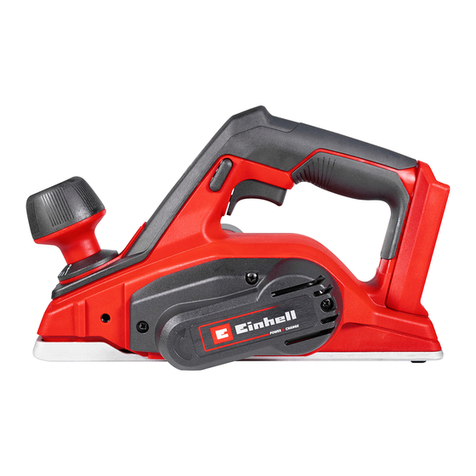
EINHELL
EINHELL TE-PL 18/82 Li User manual
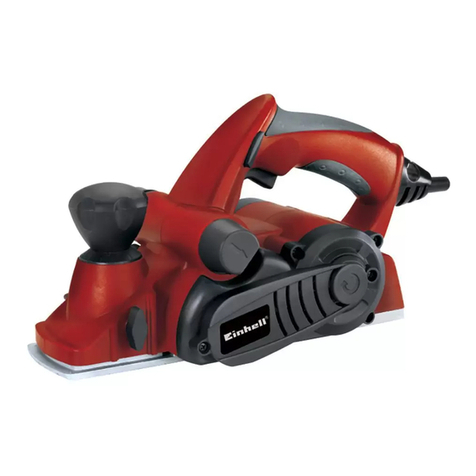
EINHELL
EINHELL RT-PL 82 User manual
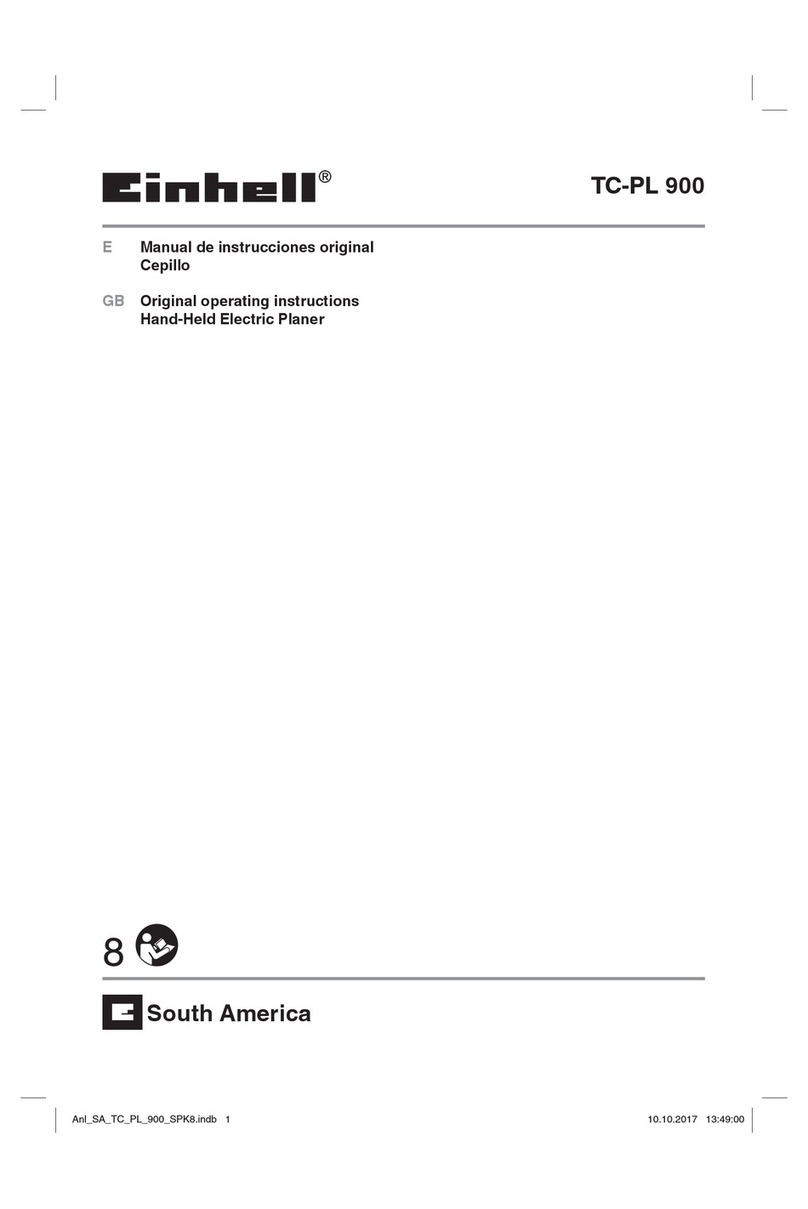
EINHELL
EINHELL TC-PL 900 User manual

EINHELL
EINHELL BT-SP 1300 User manual
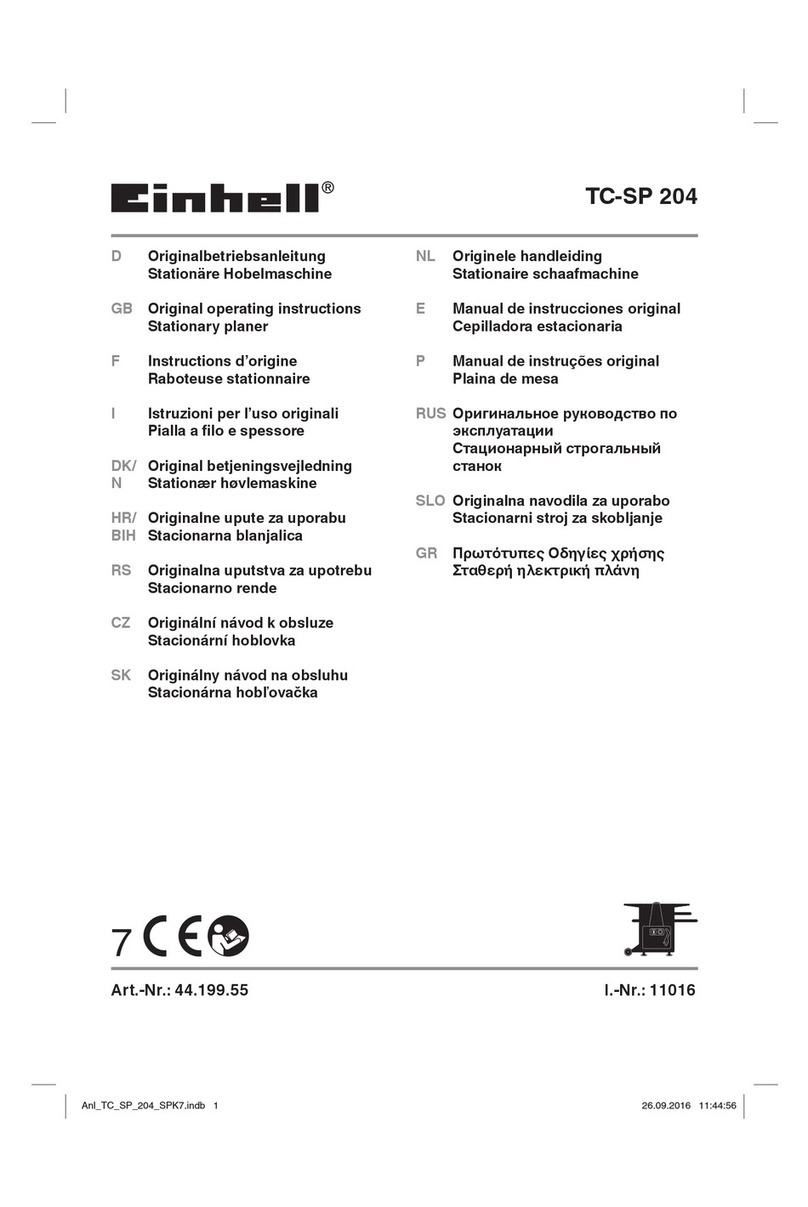
EINHELL
EINHELL TC-SP 204 User manual

EINHELL
EINHELL BT-PL 750 User manual

EINHELL
EINHELL TC-PL 900 User manual
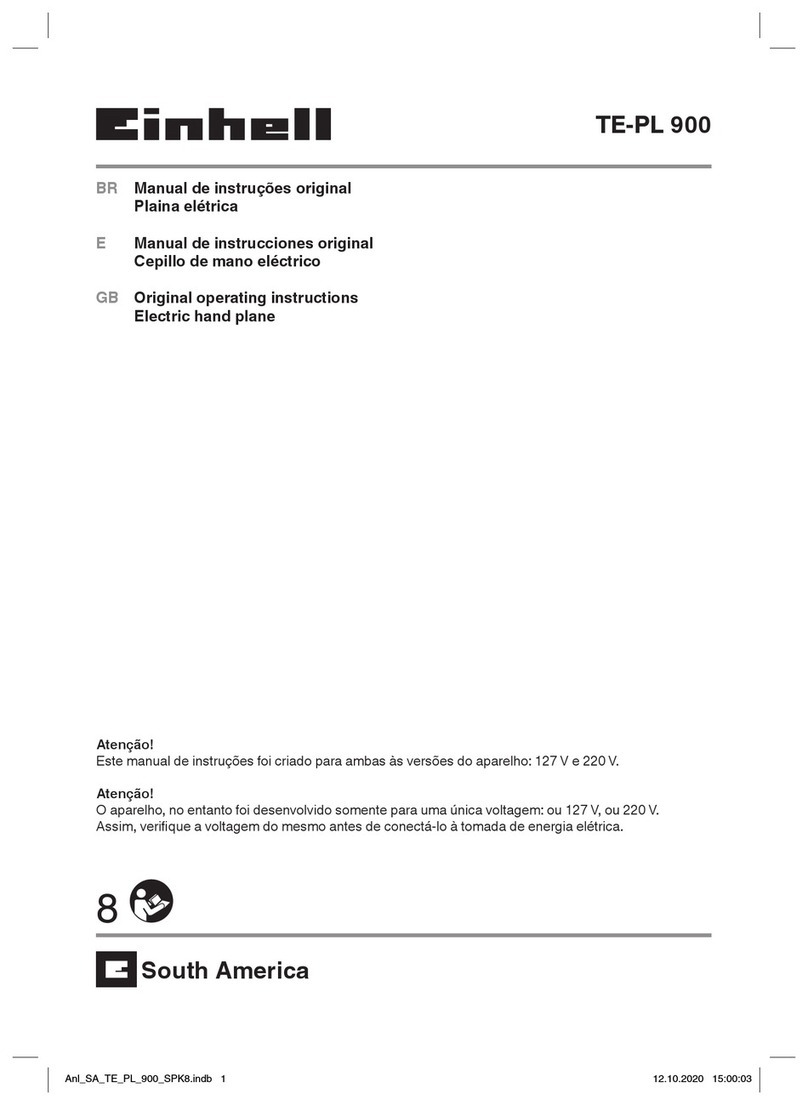
EINHELL
EINHELL TE-PL 900 User manual
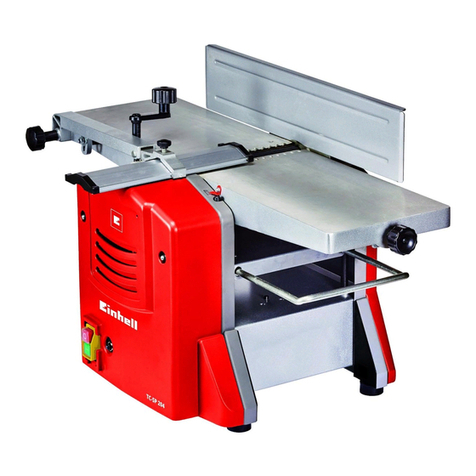
EINHELL
EINHELL TC-SP 204 User manual


